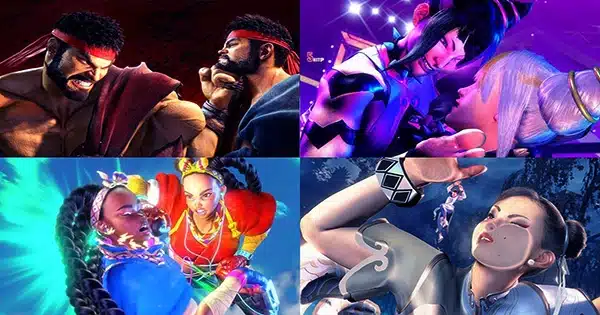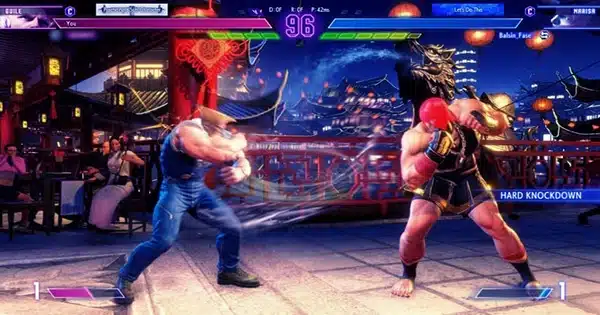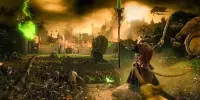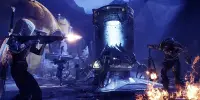Capcom’s famed combat series debuted in 1987 with the OG Street Fighter, a relatively unknown arcade game. To be honest, one-on-one fights were not the talk of the arcade crowd in the late 1980s, with games like Ghouls ‘n Ghosts, Double Dragon, Golden Axe, Outrun, and TMNT being strong favorites to swallow up our pennies.
However, when Street Fighter II debuted in arcades in 1991, it irrevocably revolutionized the genre, inspiring other iconic fighters such as Mortal Kombat, The King of Fighters, Tekken, SoulCalibur, Marvel vs. Capcom, and many more.
You’d think that after 36 years, this series would be stale. Think again, for the Street Fighter series is back with a vengeance, and unlike 2016’s SFV, the latest installment is not only multiplatform across PC, PlayStation, and Xbox, but it’s also crossplay. What a day and age we live in!
It would be easy for me to claim that Street Fighter 6 is the best in the series, and theoretically, with modern-day technology and decades of expertise behind Capcom’s devs, I believe I could. But, with so many submissions, each of which means something different to each individual fan, it’s nearly impossible for me to pick a clear favorite. What I will say is that Street Fighting 6 is a strong contender for the modern fighting crown, and if you enjoy the series, you’re in for a real treat.

Street Fighter 6 is a looker, and may I say, the best-looking game in the series. It’s powered by Capcom’s in-house RE Engine, the same software that powers the current Resident Evil titles. Character models are brought to life in a lush cartoon manner that improves on the previous game, but this time we get a spectacular splash of brilliant rainbow paint that lets the players know they’ve just pulled off an awesome power move to lay down their opponents in style.
Speaking of aesthetics, on new-gen consoles, Street Fighter 6 has two modes: one that prioritizes resolution and the other that prioritizes performance. I’m not usually one to claim that I favor resolution over graphics because it varies from game to game. That said, with a game this fast-paced and high-octane, I’ll be picking performance every day of the week, and again on Sunday.
Speaking of options, the three control schemes are likely the most significant change to Street Fighter 6, at least in terms of gameplay. Players can select the Classic 6-button configuration, which seasoned veterans will be familiar with. Then we have two new possibilities. Modern controls allow the user to perform special moves without needing to recall lengthy quick-prompted combos, but some of that remains. Finally, Dynamic may perform extraordinary moves with a single button press.
I can see why some gamers could be put off by the two new control schemes, particularly the Dynamic option. But what I will say is that these alternatives can go beyond an anticipated skill level. Accessibility is always crucial in video games, and there could be a variety of reasons why certain gamers choose a particular control system. At the end of the day, the usual option remains, but there are now a couple more options available should a player require them for whatever reason.
Street Fighter 6’s accessibility is further enhanced with aural cues that indicate how far you are from an opponent, how powerful an attack is, and how much of your Drive Gauge (the meter that fuels special attacks) remains. Capcom has gone above and beyond what fans of this genre are accustomed to, which is a huge plus for so many.
Furthermore, Street Fighter 6 features a returning training mode as well as extensive character manuals, allowing you to get to know your favorite character a little better or learn about a new favorite.
This series is frequently about bragging rights and kicking ass. That emphasis remains, but Street Fighter 6 features a plethora of modes that will keep fans entertained for months if not years. ‘Fighting Grounds’ contains the game’s more classic modes. At launch, the game includes the conventional Arcade mode with an extra tale for any of the 18 playable characters (six of which are new), as well as Versus (including Team Battle), Online, Practice, and Special Match.
The Special fight option piqued my interest especially because it allows you to deviate from the norm and select a range of bizarre requirements such as the first person to get a certain number of knockdowns wins, a back-and-forth seesaw mode with bulls, bombs, and other objects entering the fight, and so on. When playing couch Vs with friends, I envision a lot of fun to be had, especially with the Special Match kinds.
A first for the series is the addition of play-by-play commentators in both English and Japanese. The commentary works surprisingly well and does an excellent job of calling the action, making it feel extremely esports-like. Capcom Pro Tour commentators Steve “TastySteve” Scott, Jeremy “Vicious” Lopez, James “jchensor” Chen, and even WWE’s Thea Trinidad aka Zelina Vega are among them.
Battle Hub and World Tour are the other two main features of SF6. To begin, Battle Hub, as the name suggests, is a hub where the online community can meet new people, show off their custom avatar (more on that later), have some fisty cuffs, enter tournaments, and even play some classic Capcom games like Final Fight and, of course, Street Fighter II. More games are expected to appear on a rotational basis in the future. The Battle Hub might be thought of as Capcom’s version of PlayStation Home for the PS3 era.
Following that is World Tour, which is Street Fighter 6’s story mode. Before beginning this adventure, you will be asked to create your own avatar, which will be utilized not only in World Tour but also in the Battle Hub. Character creation is surprisingly deep, with capabilities for both realistic and crazy creations.
It’s wonderful to finally have a creative suite in a mainline Street Fighter game. You can not only build your own distinct look, but as you continue through the tale, you will be able to mix up your combat style as you meet renowned characters from the series throughout the campaign.
Furthermore, as you go through World Tour, you’ll be able to gain new talents and abilities inspired by the RPG genre, which is something I didn’t expect to see in this series but is a great surprise nonetheless. World Tour also allows you to explore an open globe filled with different locales, NPCs to battle, iconic characters to bond with, shops to buy new equipment, and, of course, to enjoy its fairly straightforward tale.
I loved the cinematic presentation of Street Fighter V’s story campaign (despite its late debut). Unfortunately, the World Tour isn’t all that cinematic, but it’s still a fun feature that shouldn’t be overlooked. As much as I’ve enjoyed World Tour, I’ve become tired of frequent NPCs challenging me to fight throughout its maps every minute or so. Even if it is a little quibble.
In some ways, the relentless bombardment of NPC brawls reminds me of the Yakuza/Like a Dragon series, only worse. At the very least, Cacom is trying something fresh with the Street Fighter franchise, so credit where credit is due. However, let’s be honest: as much as I enjoy a good narrative mode, it’s definitely not the main reason most people come here. Still, it’s wonderful to have options and variety, much like with accessibility features. Oh, and the World Tour takes place in Metro City, something Final Fight aficionados will appreciate.
To summarize, if you pick up this game for whatever reason, you will not be disappointed. Street Fighter 6 not only looks better than ever thanks to the RE Engine, but it also performs better and is unquestionably the most accessible. Whether you’re new to the series or a seasoned veteran, Street Fighter 6 is vivid, packs a wicked punch, and, not for the first time, reminds us why this game has remained relevant for decades, with no indications of slowing down. Mortal Kombat 1 makes your move!
Pros: Extends the pick-up-and-play premise with a slew of accessibility features, looks great, and has enough modes to keep you busy for months, if not years.
















